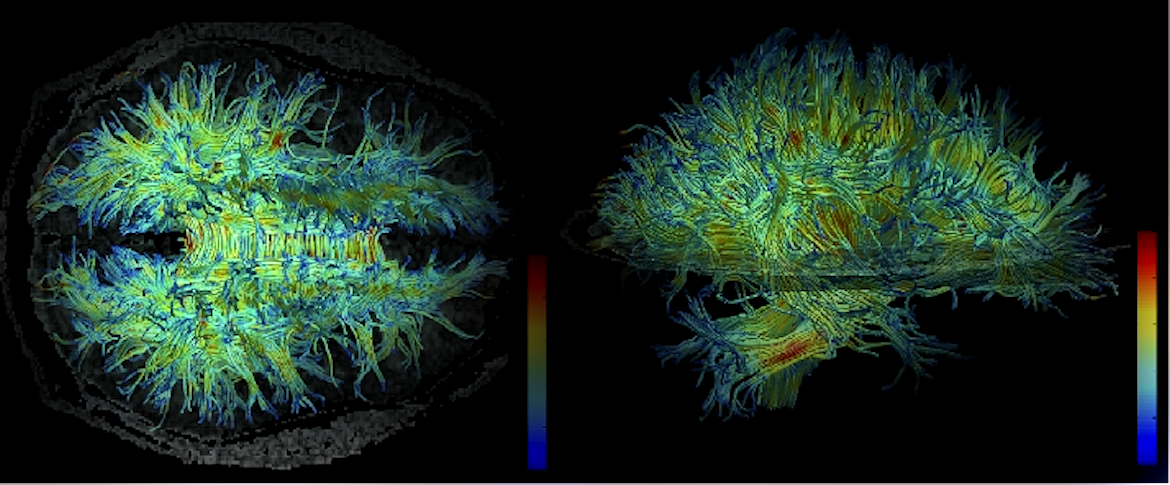
Googling “neural networks” results in lists of computer models of brain networks for artificial intelligence (AI). But even more radical than AI, is the emerging understanding that the brain comprises changing networks. It isn’t just static anatomical structures fused together.
“Network neuroscience conceptualizes the brain as a connectome—an intricate network map of the brain where brain regions synchronize their activity via myriads of interconnecting nerve fibers.”
Affective Network Neuroscience. Frontiers in Neuroscience. 11 Dec 2018
Research remains in the infant stage, but clinicians on the forefront of neurostimulation therapies are using this increasing knowledge to better understand qEEGs, why seemingly unrelated problems from brain injury are, in fact, related through being on the same network, and thus to improve treatment.
The working definition of a network is, a ‘net’ of interconnected, functionally related, group of neurons.
“Large-scale brain networks are identified by their function and provide a coherent framework for understanding cognition.”
https://en.wikipedia.org/wiki/Large-scale_brain_networks
In addition to functional connectivity, researchers are also identifying structural connectivity comprising white matter tracts, or bundles of white matter, that connect different brain regions physically. White matter is neurons that have myelin sheathes to speed up electrical conductance down their long (or short) axon arms. These sheathes appear white on scans.
Default
“The default mode network is active when an individual is awake and at rest. It preferentially activates when individuals focus on internally-oriented tasks such as daydreaming, envisioning the future, retrieving memories, and theory of mind. It is negatively correlated with brain systems that focus on external visual signals. It is the most widely researched network.”
https://en.wikipedia.org/wiki/Large-scale_brain_networks
Motor
A Google search elicits scientific articles that reflect only the barest nascent understanding. At its most basic, it’s a network involved in muscle function, things like limb movements.
Affect
Affect is about emotion. If you have no affect, you cannot feel emotion. Affect neuroscience is so complicated, trying to read it, never mind understand it, makes my head spin. Here’s one comprehensive article I found for those interested in wading into the scientific weeds.
Executive
The executive network is engaged in higher-order cognitive and attentional control and includes working memory.
Salience
In neuroscience, salience is the quality of an event that makes it stand out and direct attention to it. The salience network is so named because it identifies salient biological and cognitive events “for adaptively guiding attention and behaviour.” The network provides the key meeting points between the cognitive, homeostatic, motivational, and affective systems. Read more at Wikipedia.
Placebo
The placebo network winds through the hippocampus and is involved in memory. Placebo is remembered wellness.
A study on the thalamocortical system showed that several networks may flow through one structure of the brain, in this case the thalamus. I’m not sure how this evolving knowledge will play out — if it will combine current understandings of the brain as anatomical structures with the brain networks or if it will slowly move from anatomical to network. In the future, we may not talk about the thalamus but about the default mode network or perhaps more specifically, the medial dorsal nucleus on the default mode network.
Other studies have shown that networks communicate with each other, and neuroplasticity can enhance both connections between networks and within networks. For example, the salience network picks up on a cognitive event that needs attention. It passes that information on to the (central-)executive network that then controls attention on that event and puts it into working memory (or not) in order for the brain to process that cognitive event. An injury in both or either network would result in losing attentional control and ability to keep the event in memory long enough to process it.
The information without references came from notes I took at a talk I attended on brain injury and neuroplasticity.
